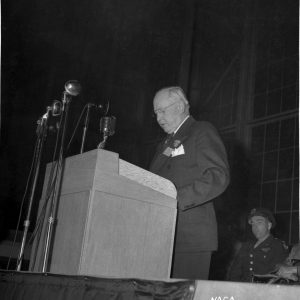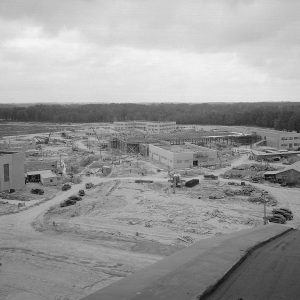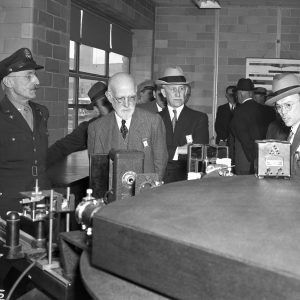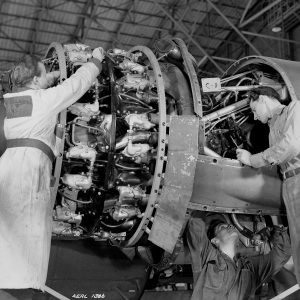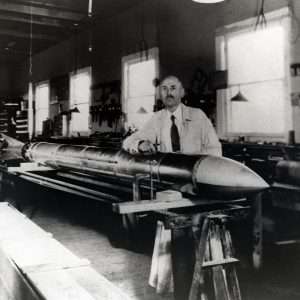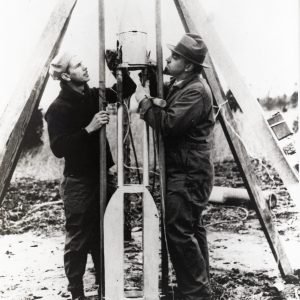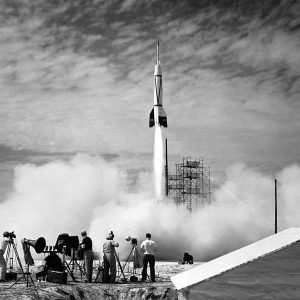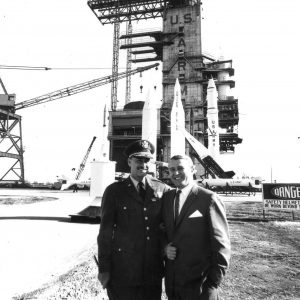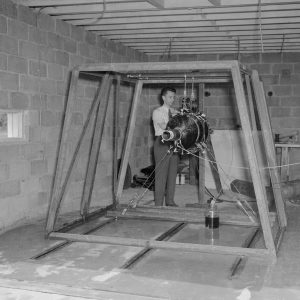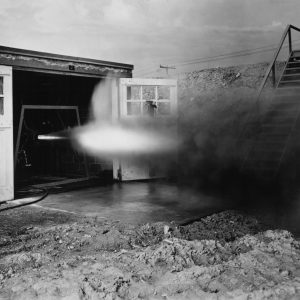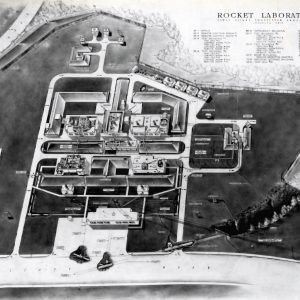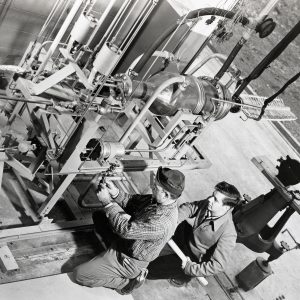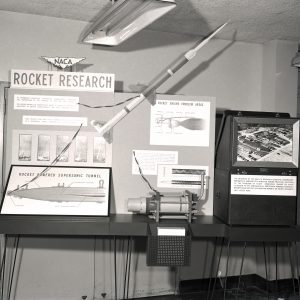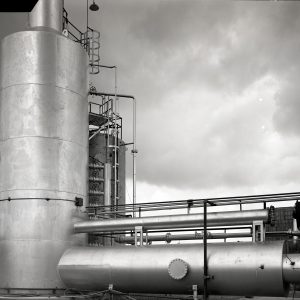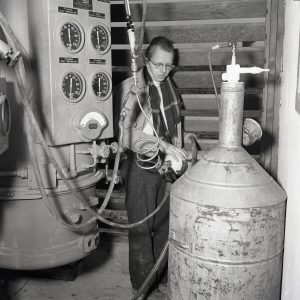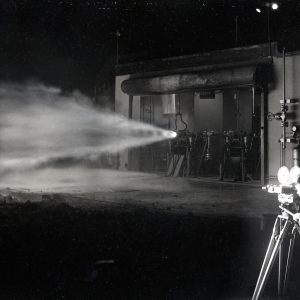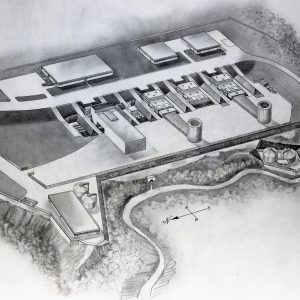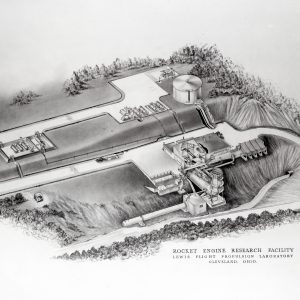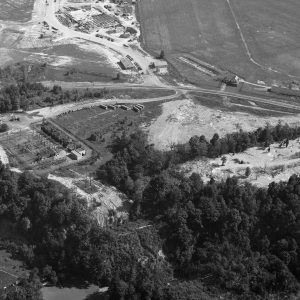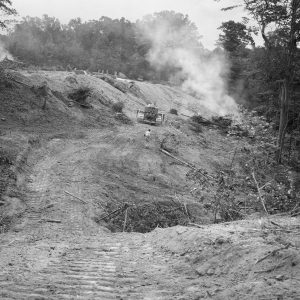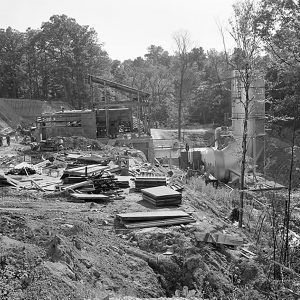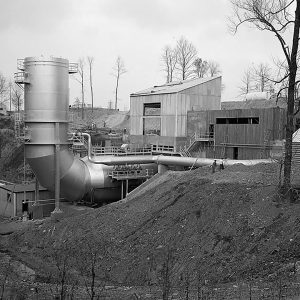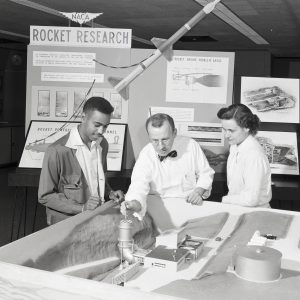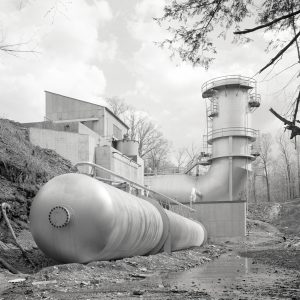Origins of the RETF
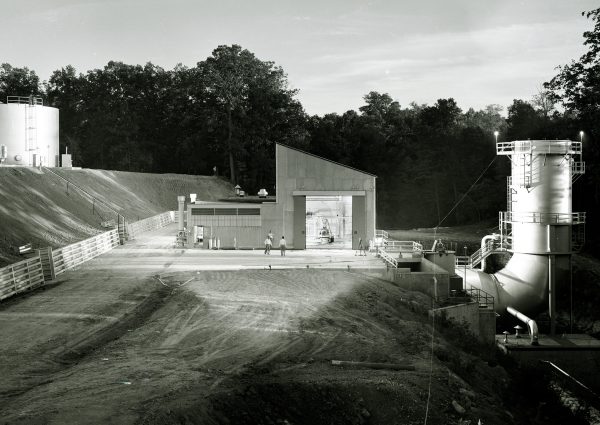
The Rocket Engine Test Facility (RETF) was a unique facility designed in the early 1950s to test high-energy propellants and rocket engine designs. The facility, which began operation at the dawn of the Space Age, played an integral part in the development of liquid hydrogen technology that powered vehicles such as the Centaur rocket and upper stages for Saturn.
Introduction
The $2.5 million RETF facility was built in a gully at the south end of the Lewis Flight Propulsion Laboratory (today the NASA Glenn Research Center), which provided a natural barrier for the combustive tests. The facility consisted of a control center on the gully’s ridge and a vertical test cell down in the valley. Engines fired in this test cell exhausted into a large scrubber which served as a muffler and a filter for toxic combustion byproducts. In the 1980s a second test cell was added adjacent to the original.
From its first test on Aug. 15, 1957, until its official shutdown on July 1, 1995, the RETF remained an experimental facility whose primary mission was to test new designs and concepts. This allowed NASA researchers to design new and improved models based on an ongoing process of analyzing their successes and failures. Technological improved resulting from RETF testing contributed to the Apollo Program, the launching of many satellites and probes, and the space shuttle.
Documents
- RETF Technical Resume (c1966)
- Brief Historical Background of RETF
- Man In Space Historic Landmark Theme Study (1984)
- RETF National Historic Landmark Listing (1984)
Establishment of the Laboratory
By the late 1930s, government laboratories in England and Germany had been conducting research into advanced aircraft engine design by the late 1930s, but the U.S. government and American corporations hesitated to commit major funding to engine development. This situation changed with the lead up World War II and the increased awareness of the crucial role that aircraft play in warfare. Many in the aeronautical field, including George W. Lewis, director of research for the National Advisory Committee on Aeronautics (NACA), saw a critical need for a government-funded laboratory devoted to engine development. In 1940 the NACA managed to secure federal funding for an engine research laboratory.
The NACA selected 200 acres adjacent to the Cleveland Municipal Airport as the site for the new lab, named the Aircraft Engine Research Laboratory (AERL). Construction began in January 1941 and most of the facilities were operational in the spring of 1943. The AERL’s initial years were focused on resolving wartime propulsion problems for military aircraft and testing early turbojet engines. The lab, however, also began exploring rocket propulsion as early as 1944 and formed a small rocket research team in 1945.
Documents
- Engines and Innovation: Lewis and American Propulsion Technology
- Bringing the Future Within Reach—Celebrating 75 Years of NASA Glenn
- NASA Glenn’s Historical Timeline
Early Rocket Development
Modern rocket engine testing dates back to 1926, when Robert Goddard, a professor at Clark University in Massachusetts, launched the world’s first liquid-fueled rocket. Liquid propellants offered greater potential performance than the traditional solid-fueled rockets. Although there were avid amateur rocketeers in the 1930s, the costs and facilities necessary for advanced research were beyond the capability of most individual researchers and non-professional societies. The U.S. government and major corporations, however, showed little interest in rockets at the time. During the same period, German scientist Hermann Oberth was conducting theoretical work on liquid-fueled rockets that would lead to the development of Wernher von Braun’s V‒2 rocket in the 1940s.
Germany’s launching of thousands of these V‒2 missiles during the final years of World War II provided the first real demonstration of the potential of liquid-fueled rockets. In the post-War years, the American military establishment used captured German engineers and technology to aggressively pursued rocket propulsion research at locations such as White Sands, New Mexico and the Redstone Arsenal near Huntsville, Alabama. The primary goal was to develop a missile capable of carrying an atomic warhead could be developed.
NACA Rocket Testing
During the post-War years, the laboratory (renamed Lewis Flight Propulsion Laboratory in 1948) focused most of its research on the improvement of technologies for early jet engines. The laboratory had a small contingent of rocket engineers, however, despite the NACA management’s belief that rockets were the military’s responsibility.
The Lewis rocket team focused on high-energy propellants since there was a general lack of knowledge in the research community. A series of cinder-block tests cells, referred to as “the Rocket Lab,” was built along the edge of the lab for hardware testing to complement the theoretical studies. Engines were fired horizontally out of the cells into the atmosphere. Four larger cells and support equipment were later added to the Rocket Lab.
Although kerosene was the standard rocket fuel used in the V-2 and other early missiles, Lewis researchers initially explored the pairing of volatile fuels such as hydrazine with oxidizers like hydrogen peroxide, chlorine trifluoride, liquid oxygen, nitrogen tetroxide and liquid fluorine. Although these liquids were toxic and difficult to handle, they promised greater power than traditional fuels. A classified NACA-sponsored conference in 1948 allowed Lewis engineers to discuss their theoretical performance and experimental data with the Navy Bureau of Aeronautics and Air Force Materiel Command. In 1949, the Navy gave Lewis Laboratory their first officially sanctioned rocket research project.
Documents
- NACA Conference on Fuels (1948)
- Rocket Research Inspection Talk (1949)
- Theoretical Performance of Some Rocket Propellants (1948)
Hydrogen Development
By 1948, Lewis engineers Paul Ordin and Riley Miller published an important theoretical study noting the high specific impulse and clean burning of liquid hydrogen. This concept was not new, however. Russian scientist Konstantin Tsiolkovsky proposed using liquid hydrogen to fuel rockets as early as 1903. Robert Goddard also considered it in the 1920s, but the technology to effectively handle the cryogenic fluid did not exist.
Researchers at The Ohio State University produced a small liquid-hydrogen and liquid-oxygen rocket engine in 1947 and experimented with it until May 1950. In California, Aerojet General Corporation and the Jet Propulsion Laboratory conducted similar small-scale hydrogen tests in the late 1940s. There were no facilities available, however, to perform the potentially dangerous larger scale testing of hydrogen propulsion systems.
Lewis researchers became increasingly interested in experimenting with liquid hydrogen just as the other institutions were ending their programs. They began testing gaseous and liquid hydrogen engines in the Rocket Lab, but were initially hampered by an insufficient supply of liquid hydrogen until the lab acquired a hydrogen liquefier in the early 1950s. Lewis tested hydrogen-fluorine and hydrogen-oxygen engines in Cell 22 of the Rocket Lab, which was also equipped with a scrubber to control the emissions. As they continued their research, they began to plan a new rocket engine test complex that was better suited to their testing needs.
Documents
- NACA High Energy Propellant Research in 1950s (1971)
- Liquid Hydrogen as a Propulsion Fuel (1945-1959)
- Procurement of Liquefier for Rocket Lab (1954)
- Liquid Hydrogen as a Jet Fuel (1955)
RETF Design and Construction
Lewis engineers felt they needed a static test stand to better evaluate high-energy propellants and rocket-engine designs. The stand had to be securely anchored to measure and evaluate the engine’s performance. The facility also required the infrastructure to deliver reactants to the stand and support the instruments that monitored the rocket’s performance. The test facility would also have to be designed to safely handle and dispose of the toxic reactants and their byproducts. The construction of a large scrubber to remove pollutants was unique at the time. Designing and building such facilities required a substantial investment and planning.
The Lewis rocket group initially proposed an $8.5 million facility that would be located on a remote site in the western U.S. The plan was eventually scaled back in 1952 to a smaller $2.5 million facility that could be built at the Lewis Laboratory. Congress approved the project in 1954 and NACA engineers began producing the blueprints the following year.
In 1955 construction of the facility began on a 10-acre site just beyond the Rocket Lab at the southern end of the Lewis property. At the time of its completion in 1957, the RETF was the largest high-energy test facility in the country capable of handling liquid hydrogen and other liquid fuels that could produce toxic exhaust.
Documents
- RETF Design Meetings (1952-54)
- RETF Design Specifications (1954)
- RETF Groundbreaking press release (1955)
- RETF Construction articles (1955-58)
- RETF Operation Bldg Location (1955)

